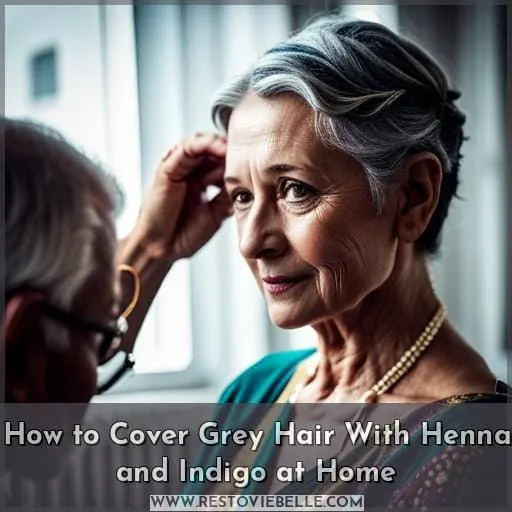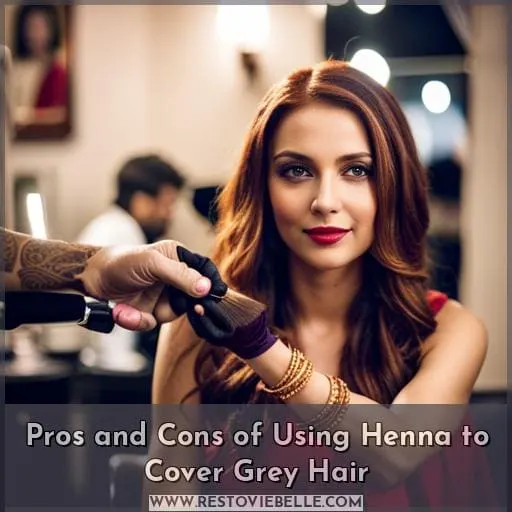This site is supported by our readers. We may earn a commission, at no cost to you, if you purchase through links.
 Are you looking for an all-natural way to cover up those pesky gray hairs? Henna hair dye is becoming increasingly popular as a great alternative to chemical dyes, but do you need a developer when using henna to cover grays? In this article, we’ll discuss everything from the effectiveness of henna in covering grays completely, how it compares with traditional hair dyeing methods, and how to use henna at home.
Are you looking for an all-natural way to cover up those pesky gray hairs? Henna hair dye is becoming increasingly popular as a great alternative to chemical dyes, but do you need a developer when using henna to cover grays? In this article, we’ll discuss everything from the effectiveness of henna in covering grays completely, how it compares with traditional hair dyeing methods, and how to use henna at home.
Table Of Contents
- Key Takeaways
- Can Henna Cover Grey Hair Completely?
- How Does Henna Compare to Hair Dye for Covering Greys?
- Choosing the Right Henna for Grey Coverage
- How to Cover Grey Hair With Henna and Indigo at Home
- Do I Need Developer to Cover Grey Hair With Henna?
- Tips for Successful Grey Coverage With Henna
- Pros and Cons of Using Henna to Cover Grey Hair
- Common Mistakes to Avoid When Using Henna for Grey Coverage
- What Brands of Henna Are Best for Covering Grey Hair?
- Conclusion
Key Takeaways
- Henna is a natural alternative to chemical hair dyes for covering gray hair.
- Henna does not require a developer and is chemical-free.
- Going lighter after using henna can be challenging.
- Adding a developer can intensify henna color and longevity.
Can Henna Cover Grey Hair Completely?
You can give gray hair a vibrant new look with henna, and you may even be able to achieve full coverage in one application! Henna’s color impact depends on the quality of the product as well as how it’s applied.
For those with grey hair looking for complete coverage, integrating indigo into their henna mix may help create blackish or dark brown results. However, success isn’t guaranteed. Applying your mixture to unclean hair or using low-quality products could prevent full coverage in one go.
Though developer (hydrogen peroxide) can be added to intensify color and longevity of traditional dyes, it isn’t necessary when using pure henna dye. This natural alternative has permanent coloring properties without chemical treatments.
While bleaching after applying henna might not always produce desired results due to its resistance against lightening agents used by many developers today, going darker is generally easier than attempting highlights after dying your locks completely red-orange from an initial all-over application.
How Does Henna Compare to Hair Dye for Covering Greys?
Comparing traditional hair dye to henna for covering greys, you’ll find that one offers a semi-permanent solution, while the other may require multiple applications. Henna can provide natural coloring with long-lasting color that won’t damage your hair like synthetic dyes.
It also has benefits such as restoring the pH balance of the scalp and making hair stronger, thicker, and shinier.
Henna is applied in a messy mud-like texture, which takes 1 – 6 hours to develop. However, roots or highlights might still be visible after application, depending on the brand used. Semi-permanent dyes might work if using multiple treatments, but bleaching isn’t easy afterwards, so going dark may be necessary instead.
Finally, consider informing your stylist about henna use beforehand, since different brands are available, each producing varying results!
Choosing the Right Henna for Grey Coverage
Are you looking to cover gray hair with henna? It’s important to choose the right quality of henna and consider mixing it with indigo for a darker, more natural-looking result.
Henna Quality
When considering grey coverage, it’s important to select a high-quality henna for the best results. The color intensity and longevity of the henna depend on the brand you choose. Some brands require adding a developer, while others don’t.
Application tips vary across brands. Two recommended brands for grey hair coverage are Morrocco Method and Lush. These brands don’t include metallic salts in their products, making them more natural options.
Apart from providing color, these top-quality hennas offer numerous benefits. They can increase hair health and give you shinier locks that last 4-6 weeks. Ultimately, picking good quality henna will have a positive impact on your overall look and scalp health.
Henna-Indigo Mix
Combining a henna and indigo mixture can give you darker, more natural results when covering gray hair.
- Always mix the Indigo powder with warm water before combining it with the henna mixture. The henna mixture consists of coffee powder, water, and henna powder, which should be left for 6-8 hours prior to application.
- Henna is a safer alternative than traditional dyes, as it offers grey coverage without any metallic salts or chemicals.
- If desired, use developer (hydrogen peroxide), but be careful not to add too much.
Allowing your stylist to know about your past usage may help during future appointments. This way, they are aware that going lighter might prove difficult after using this method on grey hair.
How to Cover Grey Hair With Henna and Indigo at Home
Covering gray hair with henna and indigo at home is a great way to restore natural color without the use of harsh chemicals. To prepare your own mixture, start by mixing henna powder, coffee powder, and water, and then let it rest for 6-8 hours.
The next step is to make an indigo mixture with warm water, which also needs time to sit before combining both mixtures.
Preparing the Henna Mixture
Mix the henna and indigo powders together to create your own grey coverage mixture. Start by adding equal parts of both powders, about 25 grams each. Then mix with warm water until you get a paste-like consistency, stirring for 10 minutes or more until all lumps are gone.
Next, add in coffee powder at a ratio of 1 teaspoon per 25 grams of henna to help deepen the color when added with indigo.
Henna and Indigo mixing is an essential part of achieving desired results from using natural hair dyes.
Preparing the Indigo Mixture
To create the indigo mixture, mix indigo powder with warm water and let it rest. Add coffee powder to henna and let it sit for 6-8 hours. After both mixtures have rested, combine them. Before applying, wash your hair with shampoo, but avoid conditioning.
It’s a natural way to cover grey hair while keeping it healthy. Adding developer intensifies color and longevity – the common guideline is 15 drops per 25 grams of henna. If you want blackish or dark brown results, mix henna with indigo. However, bleaching after use is not easy, so going darker may be necessary.
Alternatively, you can try semi-permanent dye, but you might need more applications. Make sure to inform your stylist about your henna usage beforehand. Before choosing a brand, research different options.
Look for products without metallic salts, such as Morrocco Method or Lush, for the best results when covering gray hair with henna at home.
Combining the Henna and Indigo Mixtures
After allowing both the henna and indigo mixtures to rest, you can now combine them together for a natural way of covering your grey hair! Keep in mind that mixing these two products can help achieve dark brown or blackish results with just one application.
Applying developer isn’t necessary as it will only intensify color and longevity but won’t cover gray hair. To mix, add equal parts henna and indigo mixture together until you reach a mud-like consistency.
Then apply it evenly on wet hair for the best coverage possible before rinsing out after 1-3 hours depending on the desired outcome.
With patience, practice, and quality ingredients used, this method could be an ideal choice for anyone looking to confidently conceal their greys without harsh chemicals or damaging effects!
Do I Need Developer to Cover Grey Hair With Henna?
When it comes to coloring grey hair with henna, adding developer can enhance the result and color intensity. Developer use is not necessary for covering gray hair with henna as a single application alone might do the trick.
Here are some tips on achieving optimal coverage:
- Use high-quality natural henna without any metallic salts in it for best results.
- Make sure your hair is clean before applying the dye – this will help prevent an orangey tint after application.
- Different brands of ready mixed hennas may require multiple applications to cover all grays properly so consider doing research beforehand about which one works best for you.
- Adding coffee powder or hydrogen peroxide into your mixture can also increase color intensity but be cautious when using these ingredients since they could potentially damage your scalp and strands if used incorrectly or in excess amounts!
Bleaching after using Henna should be avoided altogether as this process often requires going darker instead of lighter due to how difficult it would be otherwise achieve desired results without damaging already treated locks too much further beyond repairable levels.
Lastly, always consult a professional stylist before attempting any kind of chemical treatment on colored/hennaed hairs just so that you have access more experienced advice tailored specifically towards helping ensure healthier outcomes from such procedures!
Tips for Successful Grey Coverage With Henna
For successful grey coverage with henna, mix the right shades of colors like a painter’s palette to create your own unique masterpiece. To avoid using developer, choose only natural ingredients and experiment with different combinations for desired results.
Mixing henna and indigo can produce blackish or dark brown tones, while adding coffee powder to henna powder can deepen the color further. During application, make sure you’ve washed your hair without conditioner – this is key! Be careful when working with extensions as well; use caution as some glosses may be too strong for them.
Here are three tips:
- Choose high-quality products specifically designed for covering grey hair.
- Research before choosing between brands.
- Follow instructions carefully during each step to achieve great results every time!
With these steps followed correctly, you’ll have vibrant colored hair that will last up to four weeks without any damage thanks to its chemical-free nature and ability to stay within level families, returning back to the original hue after washings.
Pros and Cons of Using Henna to Cover Grey Hair
Choosing henna to conceal grey hair can be an empowering and natural way to give yourself a new look. Henna is a permanent dye with vibrant color that lasts 4-6 weeks, making it great for long-term coverage of grey hair.
Applying henna can be messy, so use protection when applying the mud-like texture.
It’s essential to research different brands before application, as some contain metallic salts or less natural ingredients than others. Brands like Morrocco Method and Lush are recommended by many users due to their no metallic salt formula.
After using henna on your hair, you should inform your stylist, as bleaching afterwards will not always work. Going darker may then become necessary if you wish to change the color again in future months/years.
Lastly, while adding developer (hydrogen peroxide) to intensify color longevity is possible, this could lead to orange undertones from one application. Therefore, multiple applications might be required depending on desired results.
Common Mistakes to Avoid When Using Henna for Grey Coverage
To avoid potential mishaps when using henna to cover grey, make sure to pick the right henna and developer for your hair. Don’t go for low-quality brands as they may not give you the desired results. It’s also important to mix it properly according to instructions.
Following a basic recipe isn’t always enough if you want good coverage of those stubborn grays.
If you need to go darker, be cautious when bleaching after using henna. This could potentially damage your hair follicles more than usual due to the metallic salts in some brands of dye. Additionally, semi-permanent dyes might work, but expect multiple applications before seeing any real change in color.
Consider informing your stylist about previous usage of Henna Dye beforehand so they know what type of product was used on your strands previously.
For blackish or dark brown results from covering gray hairs with henna, mixing with indigo can help achieve these colors.
Lastly, don’t forget that shampooing should only happen once prior to application, and avoid conditioning afterwards as this can reduce effectiveness too!
What Brands of Henna Are Best for Covering Grey Hair?
When it comes to covering grey hair with henna, Morrocco Method and Lush are two highly recommended brands that offer vibrant color without any metallic salts.
It is important to research different henna brands before choosing one for best results. To ensure complete coverage of grey hairs in a single application, some people may choose to add developer (hydrogen peroxide) into their mix.
Alternatively, you can make an indigo mixture by mixing indigo powder with warm water and combining it with your pre-made henna mixture after they have both rested for several hours prior to application.
This will generally produce blackish or dark brown results when used together correctly.
Henna remains the preferred method for covering gray hair due to its natural qualities and lack of chemicals compared to synthetic dyes.
Conclusion
Covering grey hair with henna can be a daunting task. After all, it’s not as simple as applying a traditional hair dye. But with the right preparation, henna can be a great way to cover grey without the harsh chemicals found in many dyes.
When it comes to covering grey hair with henna, you don’t necessarily need a developer. While a developer can be used to intensify the color and longevity of henna, it’s not necessary for single applications.
For those looking for an alternative to traditional hair dye, henna is an excellent option. With the right preparation and application, it’s possible to cover greys completely and keep your hair healthy.














